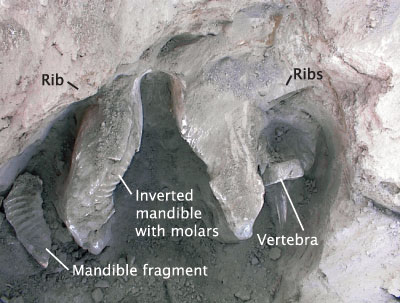Large bones were discovered along the western edge of Coyote Canyon during quarrying operations in 1999.

Bones discovered along the western edge of Coyote Canyon (2000 photo).
When it was recognized that the bones were from a mammoth, excavation was halted, and the site avoided.
In 2008, the land went up for sale, and the archeology department at Central Washington State University (CWU) was contacted to investigate this find, initially believed to be in wind blown loess deposits, similar to the Wenas Creek mammoth.
In May of 2008, a pedestrian survey conducted by CWU and Kamiakin High School students quickly found trace evidence (e.g. tooth enamel) that led the investigators to a suspected location of additional remains.
The prospect of a complete (or nearly complete) Mammoth skeleton in Ice Age flood deposits, inspired community volunteers to seek a land owner that would protect the site and allow it to be studied.
Through the dogged efforts of a local real estate agent, the land was purchased by a local farming family who wished to see the site preserved and developed into a research center for K-12 teachers, students, and community volunteers from the Tri-Cities (Kennewick, Pasco, Richland) in Washington State.
The site’s location on the edge of Coyote Canyon, gave rise to the site’s name.
In September, 2008, volunteers established the Mid-Columbia Basin Old Natural Education Sciences (MCBONES) Research Center Foundation.

